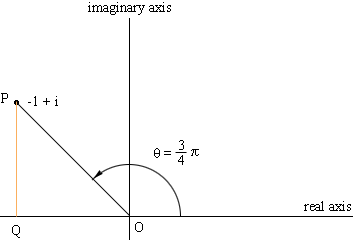| |||
| Math Central | Quandaries & Queries |
|
Subject: Exponential form When dealing with imaginary numbers in engineering, I am having trouble getting things into the exponential form. The equation is -1+i now I do know that |
Hi Austin,
To express -1 + i in the form r ei![]() = r (cos(
= r (cos(![]() ) + i sin(
) + i sin(![]() )) I think of the geometry. In the complex plane plot the point -1 + i.
)) I think of the geometry. In the complex plane plot the point -1 + i.

The modulus r of p = -i + i is the distance from O to P. Since PQO is a right triangle Pythagoras theorem tells you that r = √2. The argument of P is the angle, ![]() measured counterclockwise from the positive real axis to the line segment OP. Here
measured counterclockwise from the positive real axis to the line segment OP. Here ![]() = 3/4
= 3/4 ![]() . Cos( 3/4
. Cos( 3/4 ![]() ) = -1/√2 and sin(3/4
) = -1/√2 and sin(3/4 ![]() ) = 1/√2. Thus
) = 1/√2. Thus
You don't need to use the diagram. The modulus of x + iy is √(x2 + y2) which for -i + i is
r = √((-1)2 + 12) = √2
Also x = r cos (![]() ) and y = r sin(
) and y = r sin(![]() ) so -1 = √2 cos (
) so -1 = √2 cos (![]() ) and 1 = √2 sin (
) and 1 = √2 sin (![]() ). This gives
). This gives ![]() = 3/4
= 3/4 ![]() .
.
Penny
 |
||
Math Central is supported by the University of Regina and The Pacific Institute for the Mathematical Sciences.